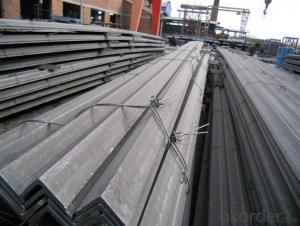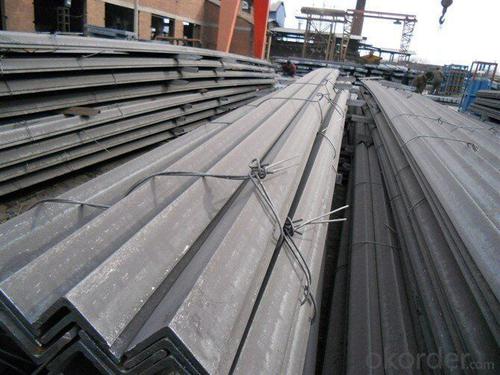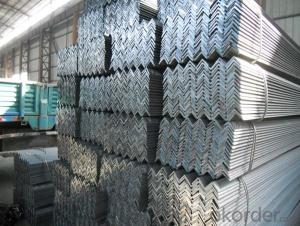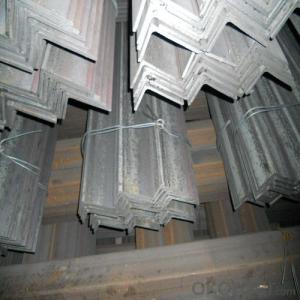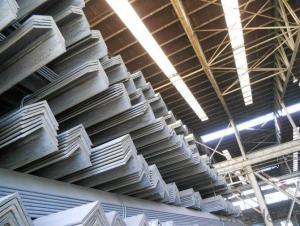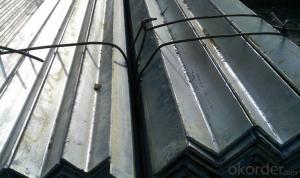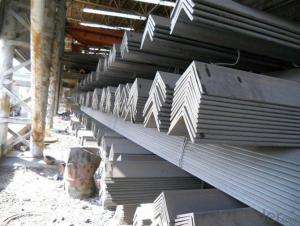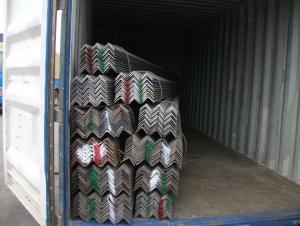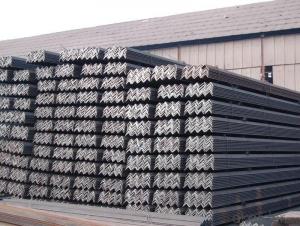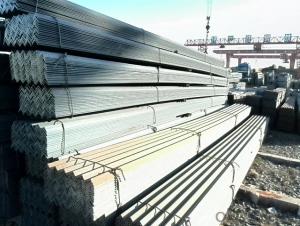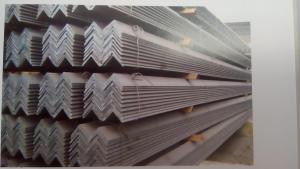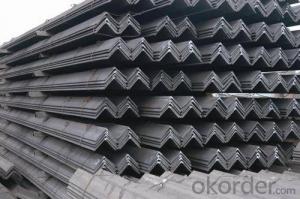2015 Hot Rolled Angle Steel in GB Standard
- Loading Port:
- Tianjin
- Payment Terms:
- TT OR LC
- Min Order Qty:
- 25 m.t.
- Supply Capability:
- 20000 m.t./month
OKorder Service Pledge
OKorder Financial Service
You Might Also Like
Specification
OKorder is offering high quality Hot Rolled Steel Angle at great prices with worldwide shipping. Our supplier is a world-class manufacturer of steel, with our products utilized the world over. OKorder annually supplies products to European, North American and Asian markets. We provide quotations within 24 hours of receiving an inquiry and guarantee competitive prices.
Product Applications:
Hot Rolled Steel Angles are ideal for structural applications and are widely used in the construction of buildings and bridges, and the manufacturing, petrochemical, and transportation industries.
Product Advantages:
OKorder's Steel Angles are durable, strong, and resist corrosion.
Main Product Features:
· Premium quality
· Prompt delivery & seaworthy packing (30 days after receiving deposit)
· Corrosion resistance
· Can be recycled and reused
· Mill test certification
· Professional Service
· Competitive pricing
Product Specifications:
Manufacture: Hot rolled
Grade: Q195 – 235
Certificates: ISO, SGS, BV, CIQ
Length: 6m – 12m, as per customer request
Packaging: Export packing, nude packing, bundled
Sizes: 25mm-250mm | ||
a*t | ||
25*2.5-4.0 | 70*6.0-9.0 | 130*9.0-15 |
30*2.5-6.6 | 75*6.0-9.0 | 140*10-14 |
36*3.0-5.0 | 80*5.0-10 | 150*10-20 |
38*2.3-6.0 | 90*7.0-10 | 160*10-16 |
40*3.0-5.0 | 100*6.0-12 | 175*12-15 |
45*4.0-6.0 | 110*8.0-10 | 180*12-18 |
50*4.0-6.0 | 120*6.0-15 | 200*14-25 |
60*4.0-8.0 | 125*8.0-14 | 250*25 |
FAQ:
Q1: Why buy Materials & Equipment from OKorder.com?
A1: All products offered byOKorder.com are carefully selected from China's most reliable manufacturing enterprises. Through its ISO certifications, OKorder.com adheres to the highest standards and a commitment to supply chain safety and customer satisfaction.
Q2: How do we guarantee the quality of our products?
A2: We have established an advanced quality management system which conducts strict quality tests at every step, from raw materials to the final product. At the same time, we provide extensive follow-up service assurances as required.
Q3: How soon can we receive the product after purchase?
A3: Within three days of placing an order, we will begin production. The specific shipping date is dependent upon international and government factors, but is typically 7 to 10 workdays.
Alloy No | Grade | Element (%) | |||||
C | Mn | S | P | Si | |||
Q235 | B | 0.12—0.20 | 0.3—0.7 | ≤0.045 | ≤0.045 | ≤0.3 | |
Alloy No | Grade | Yielding strength point( Mpa) | |||||
Thickness (mm) | |||||||
≤16 | >16--40 | >40--60 | >60--100 | ||||
≥ | |||||||
Q235 | B | 235 | 225 | 215 | 205 | ||
Alloy No | Grade | Tensile strength (Mpa) | Elongation after fracture (%) | ||||
Thickness (mm) | |||||||
≤16 | >16--40 | >40--60 | >60--100 | ||||
≥ | |||||||
Q235 | B | 375--500 | 26 | 25 | 24 | 23 | |
Images:
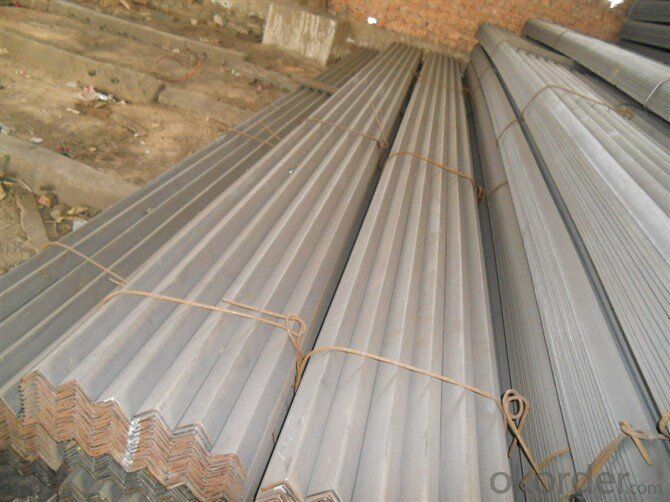
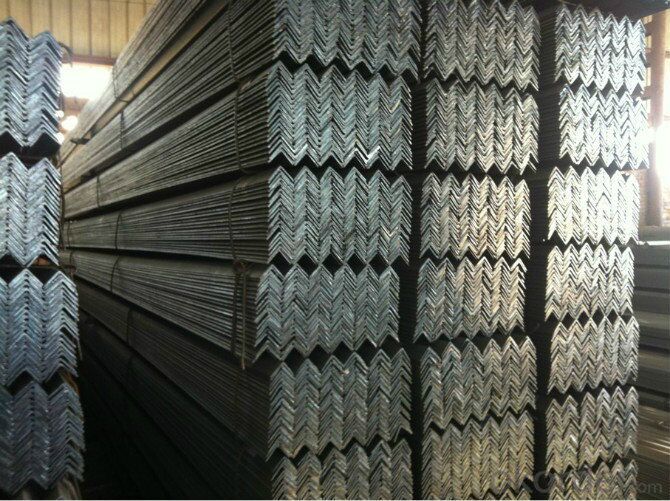
- Q: Can steel angles be used in solar panel mounting systems?
- Indeed, solar panel mounting systems can utilize steel angles. The selection of steel angles is commonly based on their robustness, longevity, and steadiness, which renders them suitable for sustaining the weight of solar panels. They can be conveniently manufactured and tailored to suit the precise prerequisites of a project. Additionally, steel angles furnish a secure foundation for solar panels, guaranteeing proper alignment and minimizing the potential harm caused by wind or other external elements. Nevertheless, it is crucial to account for the specific demands of the solar panel system and seek guidance from a structural engineer or a professional installer to ensure that the chosen steel angles fulfill the necessary load-bearing capacity and structural integrity standards.
- Q: What are the common bending or forming processes used for steel angles?
- There are several common bending or forming processes used for steel angles, depending on the desired shape and specifications. One common process is roll bending, where the steel angle is passed through a series of rollers that gradually bend it into the desired curve or shape. This process is often used for larger angles and provides precise and consistent bending. Another common process is press braking, where the steel angle is placed between a punch and die and a significant amount of force is applied to bend it into the desired shape. This process is versatile and can be used for both small and large angles, allowing for various bending angles and shapes. Hot bending is another method used for steel angles, where the angle is heated to a high temperature and then bent into the desired shape using specialized equipment. This process is suitable for larger angles and allows for more complex bending shapes. Lastly, cold bending is a popular process for steel angles, where the angle is bent using force without the need for heating. This method is commonly used for smaller angles and provides a cost-effective and efficient way to achieve simple bending shapes. Overall, the choice of bending or forming process for steel angles depends on factors such as the size, thickness, and shape requirements, as well as the desired cost and production efficiency.
- Q: What are the common industry standards for steel angles?
- The American Society for Testing and Materials (ASTM) primarily determines the common industry standards for steel angles. ASTM A36, widely recognized as a standard for structural steel angles, finds common usage in construction and industrial applications. This standard specifies the chemical composition, mechanical properties, and other relevant characteristics of the steel angles. Another commonly used standard, ASTM A572, is specifically designed for high-strength low-alloy (HSLA) steel angles. It provides guidelines for the chemical composition, mechanical properties, and notch toughness of the angles. Additionally, several other ASTM standards, including A529, A588, and A992, dictate the requirements for specific types of steel angles used in different applications. By ensuring that steel angles meet the necessary quality and performance criteria, these standards enable consistent and reliable use across various industries.
- Q: How do steel angles contribute to the overall safety of a building?
- Angle irons, also known as steel angles, play a vital role in improving the overall safety of a building. These structural elements have unique properties and advantages that make them widely used in construction. To begin with, steel angles contribute to the structural support and stability of a building. They are commonly utilized to reinforce and strengthen the framework, particularly at critical load-bearing points. By distributing and transferring weight and forces, steel angles prevent excessive deflection or deformation of the building, ensuring its integrity and stability, even under heavy loads or adverse conditions. This reinforcement is particularly crucial in tall buildings or structures located in earthquake-prone or high-wind regions. Moreover, steel angles enhance the safety of a building by acting as protective barriers or shields against potential hazards. For instance, they can be installed as guards or handrails on staircases, balconies, or elevated platforms. These barriers play a vital role in preventing accidental falls or injuries, creating a secure environment for occupants. Steel angles can also be utilized to create safety barriers around machinery or equipment, preventing unauthorized access or accidental contact. Additionally, steel angles contribute to enhancing fire resistance in buildings. Steel is inherently fire-resistant and does not contribute to the spread of flames. By incorporating steel angles into the structural design of a building, it becomes possible to effectively support fire-rated walls, partitions, or fireproof doors. This facilitates the compartmentalization of the building, slowing down the spread of fire and allowing occupants more time to evacuate safely. Furthermore, steel angles offer longevity and durability, making them an ideal choice for long-term safety. Steel is highly resistant to corrosion, weathering, and other environmental factors, ensuring the structural integrity of the building over time. This durability reduces the risk of sudden structural failures or collapses, thereby enhancing overall safety for occupants and nearby structures. In conclusion, steel angles play a significant role in improving the overall safety of a building. Their ability to provide structural support, act as barriers, enhance fire resistance, and offer durability make them crucial components for ensuring the stability and protection of a structure and its occupants.
- Q: Are steel angles prone to rust or corrosion?
- Yes, steel angles are prone to rust or corrosion as they are typically made of carbon steel, which is susceptible to rusting when exposed to moisture and oxygen.
- Q: What are the different types of connections for steel angles?
- Depending on the specific application and load requirements, there are various connection types available for steel angles. Some commonly used connections for steel angles include: 1. Welded connections: The most frequently employed connection type for steel angles involves welding the angle to the supporting structure or to another angle, creating a strong and rigid connection. Welded connections are typically utilized in applications where high load capacity and stability are essential. 2. Bolted connections: Bolts are used to connect the steel angles to the supporting structure or to other angles in bolted connections. This connection type allows for easy assembly and disassembly, making it suitable for applications where flexibility and adjustability are important. 3. Riveted connections: In riveted connections, rivets are used instead of bolts to secure the steel angles. This type of connection offers a robust and durable connection and is commonly found in structural applications. 4. Clip connections: Clip connections involve the use of steel clips to connect the angles to the supporting structure. This connection type is often employed in applications where ease of installation and flexibility are prioritized. 5. Moment connections: Moment connections are utilized to transfer bending moments between steel angles and the supporting structure. These connections are specifically designed to provide rigidity and stability in applications where high load capacity and resistance to lateral forces are required. 6. Gusset plate connections: Gusset plate connections involve the use of steel plates to connect the steel angles to the supporting structure. These connections provide additional strength and stability and are commonly employed in applications where heavy loads and high stresses are anticipated. It is important to consider various factors, such as the specific application, load requirements, and design considerations when selecting the appropriate connection type. Consulting with a structural engineer or a professional in steel construction is recommended to ensure the suitability of the chosen connection type for a specific project.
- Q: Are there any limitations or restrictions on the use of steel angles in certain applications?
- Yes, there are limitations and restrictions on the use of steel angles in certain applications. These restrictions mainly depend on the specific engineering requirements, load bearing capacity, and structural stability needed for the application. Additionally, factors such as the type of project, environmental conditions, and building codes and regulations may also impose limitations on the use of steel angles. It is important to consult with a structural engineer or an industry professional to ensure proper selection and usage of steel angles for specific applications.
- Q: How do steel angles perform in terms of impact resistance?
- Steel angles are known for their excellent impact resistance due to their structural properties and high tensile strength. They can effectively absorb and distribute the force from impacts, making them highly reliable in applications where impact resistance is crucial.
- Q: How do steel angles contribute to the overall stability of a building frame?
- Steel angles contribute to the overall stability of a building frame by providing structural support and reinforcement. They are commonly used as braces and connections in building frames to increase their load-bearing capacity and resist forces such as wind, earthquakes, and heavy loads. The angles help distribute and transfer the loads throughout the structure, enhancing its stability and preventing deformation or collapse.
- Q: How do you determine the resistance to lateral-torsional buckling of a steel angle?
- To determine the resistance to lateral-torsional buckling of a steel angle, several factors need to be considered. These include the cross-sectional properties of the angle, the length of the member, the loading conditions, and the support conditions. The resistance can be determined by analyzing the critical load that causes buckling using established equations and methods, such as the Euler's buckling formula or finite element analysis. It is essential to ensure that the applied load does not exceed the critical buckling load to maintain structural integrity and safety.
Send your message to us
2015 Hot Rolled Angle Steel in GB Standard
- Loading Port:
- Tianjin
- Payment Terms:
- TT OR LC
- Min Order Qty:
- 25 m.t.
- Supply Capability:
- 20000 m.t./month
OKorder Service Pledge
OKorder Financial Service
Similar products
Hot products
Hot Searches
Related keywords
